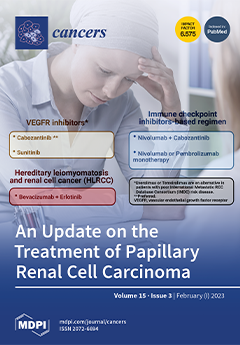Individuals with cystic fibrosis (CF), caused by biallelic germline mutations in the cystic fibrosis transmembrane conductance regulator (
CFTR), have higher risk and earlier onset of colorectal cancer (CRC). A subset of CRC patients in the non-CF population expresses low levels of
[...] Read more.
Individuals with cystic fibrosis (CF), caused by biallelic germline mutations in the cystic fibrosis transmembrane conductance regulator (
CFTR), have higher risk and earlier onset of colorectal cancer (CRC). A subset of CRC patients in the non-CF population expresses low levels of tumoral
CFTR mRNA which may also cause decreased CFTR activity. To determine the consequences of reduced
CFTR expression in this population, we investigated association of tumoral
CFTR expression with overall and disease-specific mortality in CRC patients.
CFTR mRNA expression, clinical factors and survival data from 1177 CRC patients reported in the Cancer Genome Atlas (TCGA) and Gene Expression Omnibus studies GSE39582 and GSE17538 were included. Log-transformed and z-normalized [mean = 0, standard deviation (SD) = 1]
CFTR expression values were modeled as quartiles or dichotomized at the median. Univariate and multivariable Cox proportional hazards regression models were used to estimate hazard ratios (HR) and 95% confidence intervals (CI) for overall and disease-specific mortality in individual studies and meta-analyses. Analyses of each of the three individual datasets showed a robust association of decreased
CFTR expression with increased mortality. In meta-analyses adjusted for stage at diagnosis, age and sex,
CFTR expression was inversely associated with risk of overall death [pooled HR (95% CI): 0.70 (0.57–0.86)] and disease-specific death [pooled HR (95% CI): 0.68 (0.47–0.99)]. Associations did not differ by stage at diagnosis, age, or sex. Meta-analysis of overall death stratified by microsatellite instable (MSI) versus microsatellite stable (MSS) status indicated potential interaction between MSI/MSS status and
CFTR expression, (
p-interaction: 0.06). The findings from these three datasets support the hypothesis that low
CFTR expression is associated with increased CRC mortality.
Full article






